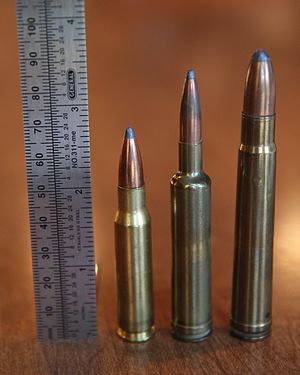.257 Weatherby Magnum
| .257 Weatherby Magnum | ||||||||||||||||||||
|---|---|---|---|---|---|---|---|---|---|---|---|---|---|---|---|---|---|---|---|---|

.257 Weatherby Magnum (center) with .308 Winchester (left) and .375 H&H Magnum (right).
|
||||||||||||||||||||
| Type | Rifle | |||||||||||||||||||
| Place of origin | United States | |||||||||||||||||||
| Production history | ||||||||||||||||||||
| Designer | Roy Weatherby | |||||||||||||||||||
| Designed | 1944 | |||||||||||||||||||
| Manufacturer | Weatherby | |||||||||||||||||||
| Produced | 1948 – present | |||||||||||||||||||
| Specifications | ||||||||||||||||||||
| Parent case | .375 H&H Magnum | |||||||||||||||||||
| Bullet diameter | .257 in (6.5 mm) | |||||||||||||||||||
| Neck diameter | .283 in (7.2 mm) | |||||||||||||||||||
| Shoulder diameter | .492 in (12.5 mm) | |||||||||||||||||||
| Base diameter | .512 in (13.0 mm) | |||||||||||||||||||
| Rim diameter | .5315 in (13.50 mm) | |||||||||||||||||||
| Rim thickness | .051 in (1.3 mm) | |||||||||||||||||||
| Case length | 2.545 in (64.6 mm) | |||||||||||||||||||
| Overall length | 3.209 in (81.5 mm) | |||||||||||||||||||
| Case capacity | 84 gr H2O (5.4 cm3) | |||||||||||||||||||
| Rifling twist | 1 in 10 in (250 mm) | |||||||||||||||||||
| Primer type | Large Rifle (magnum) | |||||||||||||||||||
| Maximum pressure | 65,000 psi (450 MPa) | |||||||||||||||||||
| Ballistic performance | ||||||||||||||||||||
|
||||||||||||||||||||
|
Test barrel length: 26 Source(s): Weatherby |
||||||||||||||||||||
The .257 Weatherby Magnum is a .257 Caliber (6.35 mm) belted bottlenecked cartridge. It is one of the original standard length magnums developed by shortening the .375 H&H Magnum case to approx. 2.5 in (64 mm). Of the cartridges developed by Roy Weatherby, the .257 Weatherby Magnum was known to have been his favorite, and the cartridge currently ranks third in Weatherby cartridge sales, after the .30-378 Weatherby Magnum and the .300 Weatherby Magnum.
The .257 Weatherby Magnum is among one of the flattest shooting commercial cartridges. It is capable of firing a 115 gr (7.5 g) Nosler Ballistic Tip bullet at 3,400 ft/s (1,036 m/s) generating 2,952 ft·lbf (4,002 J) of energy which is comparable to factory loadings of the .30-06 Springfield and the .35 Whelen in terms of energy.
Discrepancies between the metric and U.S. diameters of the bullet may cause some confusion. A .257 bullet has a metric bullet diameter of 6.53 mm. However, in Europe cartridge designation nomenclature for a large part relies on the bore diameter. As the bore diameter of the rifle is .250 inches this would make the .257 Weatherby Magnum a 6.35 mm caliber cartridge rather than a 6.5mm caliber cartridge.
The .257 Weatherby Magnum was designed in 1944 and introduced commercially in 1945 by Roy Weatherby as a wildcat cartridge as a chambering in his rifles. The 257 Weatherby Magnum is one of Roy Weatherby's favorite calibers. The original cartridge was developed using the H&H Super 30 (a close variant of the .300 H&H Magnum which in turn is based on the .375 H&H Magnum) shortened, blown out, and necked down to accept a .25 caliber (6.35 mm) bullet. Together with the .270 Weatherby Magnum, the 7mm Weatherby Magnum, and the .300 Weatherby Magnum, the .257 Weatherby Magnum were the earliest cartridges introduced by Roy Weatherby.
The original cartridges were formed using Winchester's .300 H&H Magnum (H&H Super 30) and was only available as a component from Weatherby. Beginning in 1948 Weatherby began offering loaded ammunition for the .257 Weatherby Magnum cartridge which was loaded in house. Until then the cartridge was only available as a component brass which would require being loaded before use. Sometime later, the .257 Weatherby brass was manufactured by Richard Speer for Weatherby. However, due to space and organizational constraints Weatherby began looking for a source of ammunition for his cartridge. The search culminated in 1951 with Norma Projektilfabrik being awarded a contract to produce ammunition. Since then, all Weatherby Ammunition has been manufactured by Norma with the exception of a brief period of time between 1963 and 1964 when production moved to RWS/Dynamit-Nobel, a company which had entered into partnership with Weatherby.
...
Wikipedia
